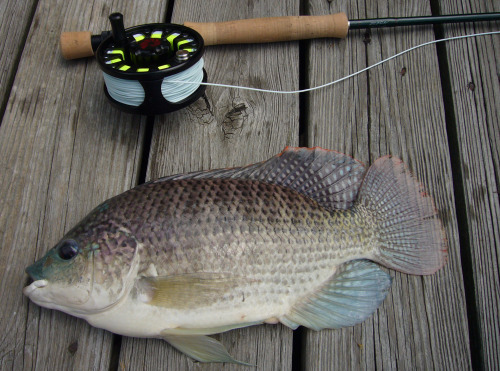 A fly rod is a great way to pursue this widespread cichlid, but you have to get up early. Photo: Michael Rupert HayesFamily: Cichlidae
A fly rod is a great way to pursue this widespread cichlid, but you have to get up early. Photo: Michael Rupert HayesFamily: Cichlidae
Scientific names: (three primary species in Taiwan, though most “wild” specimens are hybrids. Oreochromis mossambicus, Oreochromis niloticus, Oreochromis aureus, Tilapia zillii
Common names: (respectively) Mozambique tilapia, Nile tilapia, blue tilapia, red-bellied tilapia
Habitat: Slow moving rivers and canals, ponds, lakes and swamps. Can tolerate low oxygen levels and high pollution. Prefers areas of heavy aquatic vegetation, its main food source. Prefers warm water and is sensitive to drops in temperature.
Size range: Large specimens can reach 40-60 cm, depending on species. Individuals under 1 kg. are more common. Typically, tilapia size is determined by competition for food. Larger population concentrations result in smaller fish.
Angling tactics: Most local anglers fish with prepared baits or worms. Flies can be productive depending on time of day. Large specimens have been known to strike top-water lures when spawning/brooding.
Love them or hate them, tilapia are one of the most commonly pursued freshwater fishes in Taiwan. This is mostly due to their ubiquitous nature and ability to flourish nearly everywhere warm fresh water can be found. Urban rivers, canals, farm ponds and swamps are all likely places to find tilapia. Their prevalence leads some “serious” anglers to turn their noses up at this fascinating import that has played a key role in the island’s aquaculture industry.
Widespread though they may be, tilapia can be fun and challenging to catch, particularly on artificials. They are omnivores, but vegetation makes up the largest part of their diet. Many anglers swear by prepared baits, corn or bread. Worms can also work. Before dawn and just around dusk, tilapia will often begin feeding on insects and this is the best time to get out the fly rod.
Tilapia are generally considered good eating and have a mild flavor, but be mindful of the water quality in the area you are fishing. Most tilapia sold commercially or in local restaurants are farm-raised.
Tilapia are rapid breeders (individuals spawn several times a year), invasive and can push out more sensitive native species, so catch-and-release is not necessary and in some cases may even be discouraged.
Tilapia fight hard once hooked and are a particularly fun fish to catch on light tackle. Their ease in locating makes them an excellent choice for introducing young anglers to the passtime.
Further reading:
Taiwan Tilapia-- The Fish That Became a National Treasure